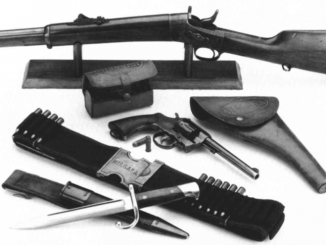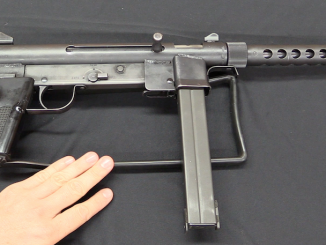Not all companies responded in the same way to the development of cartridge revolvers and the Rollin White patent. Allen & Wheelock, for example, decided to simply ignore the patent and make revolvers for their proprietary lipfire cartridges (fairly similar to rimfire) while relying on their lawyers to delay the anticipated patent infringement suit for as long as possible. Ultimately it took 4 years for Rollin White and S&W to gain a legal injunction against them, and when that did happen they were ready and converted their production to percussion revolvers of the same basic type. This particular piece is a .36 caliber (“Navy”) version for the lipfire round, which have been since converted to use either lipfire or more common rimfire ammunition.
Related Articles

Single Shot Rifles
Strange History: A Remington Rolling Block From the USS Niagara
This rifle is being sold at Morphys on October 31, 2018. The story of the USS Niagara is quite an odd little corner of history. It was a ship built in 1877 and acquired by […]

Single Shot Rifles
Sharps-Borchardt M1878 at RIA (Video)
The M1878 was the last new rifle produced by the Sharps company before it went out of business in 1881. It was the invention of none other than German gun designer Hugo Borchardt, better known […]

Submachine Guns
Smith & Wesson 76: American’s Vietnam 9mm SMG
This S&W 76 is being sold by Morphys on October 30, 2018. Early in the Vietnam War, the US Navy acquired a quantity of Swedish M/45B submachine guns (“Swedish K”) for special forces use. By […]

At the time, the lipfire round was generally considered more reliable in terms of ignition. The early rimfire rounds often didn’t have the priming compound spread evenly around the inside of the rim, and as such the point the firing pin hit might not necessarily have enough priming to set off the powder charge.
The Henry and Winchester 1866 got around this problem with firing pins that hit two points on the rim simultaneously, playing the odds that at least one had enough priming to initiate the “bang”. The lipfire relied on having just one place that could be carefully loaded to ensure ignition.
Now you know why centerfire was hailed as such an advance in the late 1860s. Even though, strictly speaking, it actually predated rimfire. (Pauly’s original break-action, single-shot breechloaders in France in the 1830s were all centerfire.)
cheers
eon
Okay, I can see why center-fire wasn’t that common in America. Giving the hammer a firing pin that will hit the dead center of the cartridge casing base is problematic if you’re a rural blacksmith. Doing it with only hammer, tongs, files and vices will make things even more difficult (I am probably wrong here). With a rim-fire setup, everything is a bit easier to make apart from placing the primer into the brass.
Weren’t some people discouraged from making center-fire actions because of the “fragile” Dreyse firing pins? And wasn’t the Swiss Vetterli series among the most successful of the early magazine fed bolt-action rifles?
I still think Rollin White would have been the worst roommate.
Considering Vetterli rifles were originally rim-fire guns but adapted to center-fire, how good was the original design in order to stay for about half a century?
Stupidity para-quotes of the era, probably from US Army:
“Ammo wastage due to magazines must be prevented by getting rid of any notion of magazines ever being used to load rifles.”
“Good old stuff and traditional thinking will always win, even against those sneaky [native American Indians].”
“Don’t trust Winchester, he just wants our money and will never give us stuff strong enough for the job.”
“Don’t read those stupid reports about Prussia’s new guns, those rifles won’t stand up to getting pounded by our bare hands!”
If I’m wrong, please feel free to address any problems you have with this post.
I still think Rollin White would have been the worst roommate.
Back then, things could get a little weird. The Moore aka National aka Colt No. 1 derringer was a case in point;
http://www.rockislandauction.com/photos/57/p_standard/FQG1-S-F1-H.jpg
It was patented in 1861, but was apparently in production under the Moore trademark before that. (The company became National Arms in 1866, and was bought out by Colt in about 1870.)
The Moore was originally a .41 rimfire, and later a .41 centerfire. But the patent drawings from 1861 clearly show it was intended to be a centerfire. There is a lot of speculation as to why it underwent this seemingly-schizophrenic transition; one possibility is that at the time, it was just easier to make rimfire ammunition than centerfire.
My personal SWAG, however, is that it was originally intended as a muzzle-loading percussion pistol. The instructions that came with the pistol stated that the forefinger was to be wrapped around the squared-off front of the receiver and the trigger pulled with the second finger.
This more-or-less automatically puts the palm of the shooting hand above the pistol, just behind the hammer. Which incidentally does a wonderful job of blocking the miniscule front sight.
This odd grip makes perfect sense if you assume the pistol was to be fired from inside a coat pocket- as when a footpad demanded “your purse, and your pretties”. The shooter’s arm would basically be pointed down, not at the target.
If it were originally designed as a percussion, the idea of it being initially redesigned as a centerfire makes sense, too. The “breech” would actually have been a system that fully enclosed the percussion cap at firing, just like a modern “in-line” percussion muzzle-loading action such as the Traditions Vortek, New England Firearms Huntsman, etc.
This would allow it to be fired from inside the pocket without the risk of injury to the shooter from cap fragments, sideflash, etc., that you normally expect from a cap-and-ball gun discharge.
And of course, if it were originally designed so that the hammer hit a centrally-positioned cap nipple, converting it to a breech-loading centerfire would require less revisions to the design than making it a rimfire.
Just a SWAG, but as I said, back then, things got a little weird, as they are prone to do in any technological “transition” period.
cheers
eon
“Considering Vetterli rifles were originally rim-fire guns but adapted to center-fire, how good was the original design in order to stay for about half a century?”
When the Vetterli rifle it was ahead of other European countries rifles, Swiss government ordered first Vetterli rifles in 1868, at this time other European countries were adopting their first breech-loaders/muzzle loading conversions
(Austrian Wanzl 1867 [converted from Lorenz rifle], Russian Krnka 1867 [converted from 6-line rifle], British Snider-Enfield 1867 [converted from Pattern 1853] just to name few)
Notice that Vetterli rifles become popular amongst sport shooters in United States, when they were sold as a surplus by Swiss Army. They are must be very popular, because as http://www.ammo-one.com/41SwissRimfireCartridges.html states ammunition for them were produced in US until 1962 (as a “41 Swiss RimFire”)
Similarly to Vetterli the Swiss revolvers were also converted from rim-fire to center-fire (rim-fire version was called: Ordonnanzrevolver 1872 and center-fire version: Ordonnanzrevolver 1872/78)
Given the number of honestly dubious firearms reviewed on this very site, perhaps we don’t give the Ordnance Department enough credit…
You have a point, when the Ordinance Board half-learned not to stick to bribe money and traditionalist whims… And yet the other half of the time the guys in charge made bone-headed decisions like giving Colonel Lewis the middle finger and dissing the idea of scaling up the Browning M2 to auto-cannon size.
The US military hasn’t deployed a whole lot of objectively poor weapons throughout its history. Certainly fewer than any other major military I can think of. Credit for that is due to the Ordnance Department, although acknowledging that fact isn’t as entertaining as talking about their errors.
Unrelated to the revolver, but I have a suggestion for your next 2 Gun match: https://www.youtube.com/watch?v=nd2kwL98lMA
Now THAT would be a real test for the HMG targets Ian and Karl seem so exited about. Well, they would be ruined unless MDZ (HEI) or ZP (Incendiary) ammunition was used. They would make quite a show…
Sorry about the double reply to your post, eon, if it has appeared. Feel free to ignore the second one if you wish.
Sort of 4/5ths rim fire 1/5th Pin fire ..